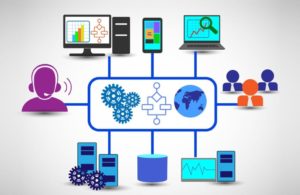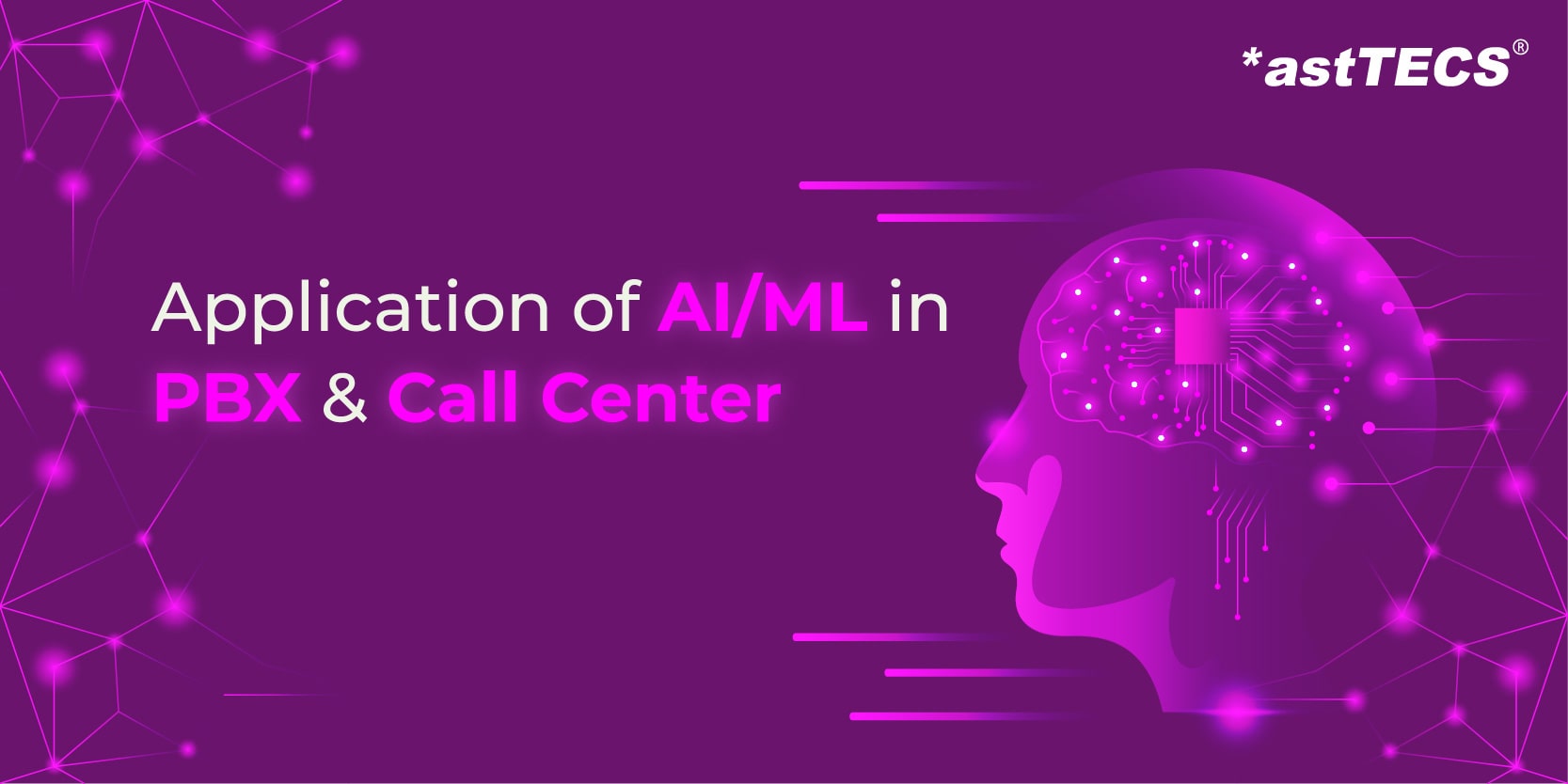AI/ML in Enterprise PBX/Call Center
Drastic advances in AI/ML (Artificial Intelligence/Machine Learning) technology combined with the emergence of specialised hardware to improve processing times has resulted in widespread application of AI/ML in all spheres of business from intelligent analysis to decision making. Parallelly, automized, smart communication is becoming the Mantra for all organizations. Communication being the heart of an organisations customer relationship, improving the quality using modern techniques involving AI/ML is of utmost importance to any organization.
AI/ML Technology
Wikipedia’s definition of AI is “the term “artificial intelligence” is often used to describe machines (or computers) that mimic “cognitive” functions that humans associate with the human mind, such as “learning” and “problem solving” ”. Machine Learning a sub-domain of AI has made large strides of innovation in recent times. ML, involving techniques to analyze large amount of data and learn from it, has made good progress in the fields of image recognition, speech recognition etc.
Smooth and effective communication forms the backbone of enterprises. Enterprises introduce multiple technologies, which helps them to store their interactions with customers and also improve the effectiveness of these communications.
Enterprises uses mainly two type of types of equipment to communicate with their customers – IP PBX and Call Center Dialer.
AI/ML in Enterprise IP PBX
IP PBX, the new age version of EPABX, organizes communication between the employees and also to the outside world. The application of newer technologies can help in reducing the costs, as well as improve the effectiveness of individual communication.
Ideally, the IP PBX in a modern organization works together with the CRM (Customer Relationship Management) system. The CRM stores all customer-relevant data and also the interactions in a chronological manner.
Call Detail Analysis – Identify Outliers
Daily Call Patterns can be fed into a Machine Learning framework. Later this could be used to identify outliers, like high call volumes, or extremely long calls, or high call volumes from a particular extension, and so on. These outliers help in the identification of mainly fraudulent patterns.
Smart IVRs
Smart IVRs are IVRs functioning in the traditional way with Speech Recognition for input. The traditional IVRs present a dialogue with a few questions and excepts DTMF inputs from the user. This is very inflexible and offers only a few choices. Also, the customer needs to spend a lot of time in the menus with multiple levels of IVR.
There are multiple benefits of IVR such as IVR can be set up for self-service, hosted IVR & agent-assisted IVR etc.
Chatbots and Voicebots
74% of the inbound calls hitting an organization are routine tasks like:-
- Where is your location?
- What are your opening times?
- Can I meet someone on a Saturday?
- Can I return the damaged goods to your office?
and so on.
IVRs used to handle some part of this previously, though, the knowledge base and dialog flow are very limited and inflexible compared to chatbots and voice bots.
Chatbots and Voicebots are based on multiple AI technologies like Speech Recognition, Natural Language Processing (NLP), Machine learning etc. Voicebots, a similar technology like IVR, goes forward and add NLP for contextual understanding, and also Machine Learning Techniques to carry on the conversation. The essential difference between chatbots and voice bots is the input media – text for chatbots and speech for voicebots.
Technically, both get to the level of a textual message and then with the help of an NLP engine understands the ‘indent’. Thereafter, if further parameters are required for the intent, the system queries them to the customer. For e.g. if the customer expresses in the ‘indent’ that he wants to book a ticket, the system queries the customer to understand the destination, date, time, etc. for the travel. After gathering all the parameters, the system executes ticket booking in the background and presents the results to the customer.
The usage of these bots have multiple advantages:
- Save Manpower
- 24×7 availability
- Higher accuracy
The future will have enterprises executing 50% of their tasks with chatbots/voicebots.
AI/ML in Enterprise Call Center

Enterprises organize Call Centers to serve special objectives like sales, customer support etc. The dialer is an equipment, which will enable processing of large number of calls based on various algorithms. Dialers normally support inbound, as well as outbound dialing. In the inbound scenario, ACD (Automatic Call Distribution) can happen with various routing rules like campaign based, skill-based, LRU etc. The inbound scenario can also include multiple levels of IVR, Queues, and so on.
The outbound call center can work in multiple modes like Manual, Progressive and Predictive Dialing. These tools were used to attain a high level of efficiency in terms of managing the calls. The managers are equipped with multiple levels of dashboards and reports to efficiently manage the workforce.
The advent of AI/ML tools marks the starting of a new era of advanced intelligent tools. The intelligence can be used to predict effective routings, analysis agent call content, quality monitoring, and reduction of manual intervention. All these together contribute to higher effectiveness and reduced cost.
Speech Recognition
Transcription of the call forms the basis for a number of analyses. Many advances in Speech recognition using Engines from Google, Deep Speech etc, a very good amount of accuracy is achieved. This brings in innumerable possibilities of analysis, which are listed in the subsequent sections.
Etiquette Analysis
Initial greetings, Parting words, Politeness during the conversation can be analyzed from the transcript obtained using the Speech Engine. Based on the country, type of call center, the agents might be trained to adhere to certain practices.
Regulatory Analysis
A typical regulatory requirement is to inform the customer that the call is being recorded for quality purposes. Further, credit card PIN is not to be queried directly by the agent, and only through an IVR. Adherence to these regulatory practices may also be checked using the transcription analysis.
Intelligent Inbound/Outbound Routing
Data exists about various call parameters like agent age, customer age, agent domicile, customer domicile, disposition, etc. The system can be fed with these experience data. Predictions can be made for desired results based on the listed features.
Campaign Filters
Machine Learning techniques can be used to identify successful patterns in customers and select customers with those features for a future campaign. A travel agent who is conducting tours to various parts of the world would like to conduct a tour to Singapore. For this purpose, he would like his employees to make calls to a few prospective customers. A machine learning framework can be trained with customers, who have undertaken Singapore tours in the past, and then filter the existing data for new prospects.
Future of AI/ML in Enterprise
Intelligent Enterprise is the Mantra for the future. The promises of Artificial intelligence and it’s penetration to all domains present an opportunity for Communication to become more and more smart.
- Analytics: Communication with the customer is the key to the relationship to the customer. So measurement and evaluation of the contact parameters will become an ingredient of effective communication. Analytics will, therefore, gain more and more importance in future.
- Natural Language Processing: A well accepted and easy to use interface is a must for any enterprise. Natural language is the interface, which can be used by all levels from Managers to sweepers in an organization. Recent advances in Speech Recognition/NLP (Natural language processing), especially using Deep Learning Techniques, makes it the natural choice for the next level interface.
- Artificial Intelligence: Intelligent Systems fuelled by Artificial Intelligence are today’s Mantra. The development of cheap computing power and modern algorithms like Deep Learning accelerated the usage of AI in all domains. The usage of AI in UC scenarios leads to much more effective organisation management.
- 5G Connectivity: The backbone of everything in communication is a ubiquitous, reliable IP network. 5G promises exactly that. Most of the carriers have started the field trails and we can expect a wide-spread rollout in the next 2 years.
Migration to a smart environment is an unquestioned strategy for any business in the next decade. AI/ML will play a significant role in achieving this goal for the enterprise of the next decade.
Obviously, AI and ML are going to change the landscape of call centers but only these 2 technologies are not responsible for changing the face of unified communication space. There are more technologies that are going to hammer the unified communication industry in 2020.
If you have any questions left related to implementation of AI/ML in call centers, then comment below or you can also contact us.






Leave A Comment